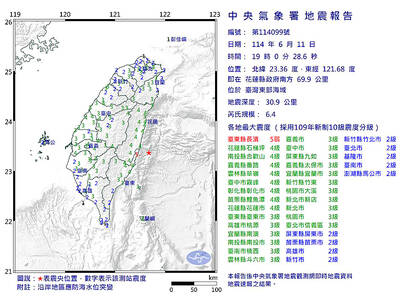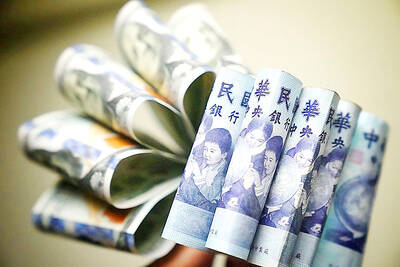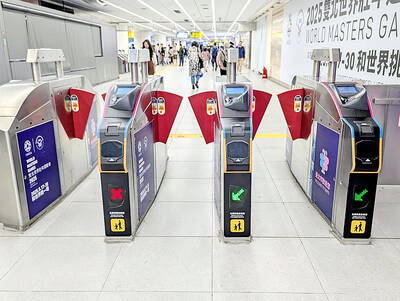Taipower chairman Chen Kuei-ming (陳貴明) told the legislature yesterday an additional NT$40 billion (US$1.15 billion) to NT$50 billion would be needed if the Fourth Nuclear Power Plant is to reach a stage where its two generator units can begin operations in 2011 and 2012.
The additional funding would bring the construction costs at the Gongliao (貢寮), Taipei County, plant to between NT$270 billion and NT$280 billion, Chen said.
Also yesterday, Minister of Economic Affairs Yiin Chii-ming (尹啟銘) said it was unlikely that the plant would be completed this year as scheduled.
“It will probably take two more years,” he said.
Meanwhile, the Atomic Energy Council (AEC) said yesterday that a “minor alteration,” costing NT$1 billion, would allow the nation’s nuclear plants to add 1.7 percent to their annual electricity, enough to supply 100,000 families.
The reactor cores of the generators had been fitted with new flow meters for feedwater, deputy director of the Department of Nuclear Regulation Hsu Ming-te (徐明德) said.
Hsu said that feedwater is injected into the reactor core to be heated and turned into steam. The steam in turn pushes the main turbine generator to generate electricity.
“Traditionally, reactors are designed to withstand 102 percent of the heating generated by the reactor,” Hsu said.
This is because feedwater that flows into the reaction core is measured by a Venturi Meter, which has a mismeasurement range of 2 percent. As 2 percent means that more water would flow into the core, the reactors could overheat, he said.
With advanced equipment, more accurate ultrasonic flowmeters (UFM) with a 0.3 percent error range are now available, Hsu said.
This means that while workers at a nuclear plant only injected 100 parts of water into the reactor cores under the assumption that an extra 2 percent may have been put in, workers can now input 101.7 parts of water.

A magnitude 6.4 earthquake struck off the coast of Hualien County in eastern Taiwan at 7pm yesterday, the Central Weather Administration (CWA) said. The epicenter of the temblor was at sea, about 69.9km south of Hualien County Hall, at a depth of 30.9km, it said. There were no immediate reports of damage resulting from the quake. The earthquake’s intensity, which gauges the actual effect of a temblor, was highest in Taitung County’s Changbin Township (長濱), where it measured 5 on Taiwan’s seven-tier intensity scale. The quake also measured an intensity of 4 in Hualien, Nantou, Chiayi, Yunlin, Changhua and Miaoli counties, as well as

Credit departments of farmers’ and fishers’ associations blocked a total of more than NT$180 million (US$6.01 million) from being lost to scams last year, National Police Agency (NPA) data showed. The Agricultural Finance Agency (AFA) said last week that staff of farmers’ and fishers’ associations’ credit departments are required to implement fraud prevention measures when they serve clients at the counter. They would ask clients about personal financial management activities whenever they suspect there might be a fraud situation, and would immediately report the incident to local authorities, which would send police officers to the site to help, it said. NPA data showed

ENERGY RESILIENCE: Although Alaska is open for investments, Taiwan is sourcing its gas from the Middle East, and the sea routes carry risks, Ho Cheng-hui said US government officials’ high-profile reception of a Taiwanese representative at the Alaska Sustainable Energy Conference indicated the emergence of an Indo-Pacific energy resilience alliance, an academic said. Presidential Office Secretary-General Pan Men-an (潘孟安) attended the conference in Alaska on Thursday last week at the invitation of the US government. Pan visited oil and gas facilities with senior US officials, including US Secretary of the Interior Doug Burgum, US Secretary of Energy Chris Wright, Alaska Governor Mike Dunleavy and US Senator Daniel Sullivan. Pan attending the conference on behalf of President William Lai (賴清德) shows a significant elevation in diplomatic representation,

The Taipei MRT is to begin accepting mobile payment services in the fall, Taipei Rapid Transit Corp said on Saturday. When the company finishes the installation of new payment units at ticketing gates in October, MRT passengers can use credit cards, Apple Pay, Google Pay and Samsung Pay, the operator said. In addition, the MRT would also provide QR payment codes — which would be compatible with Line Pay, Jkopay, iPass Money, PXPay Plus, EasyWallet, iCash Pay, Taiwan Pay and Taishin Pay — to access the railway system. Currently, passengers can access the Taipei MRT by buying a single-journey token or using EasyCard,